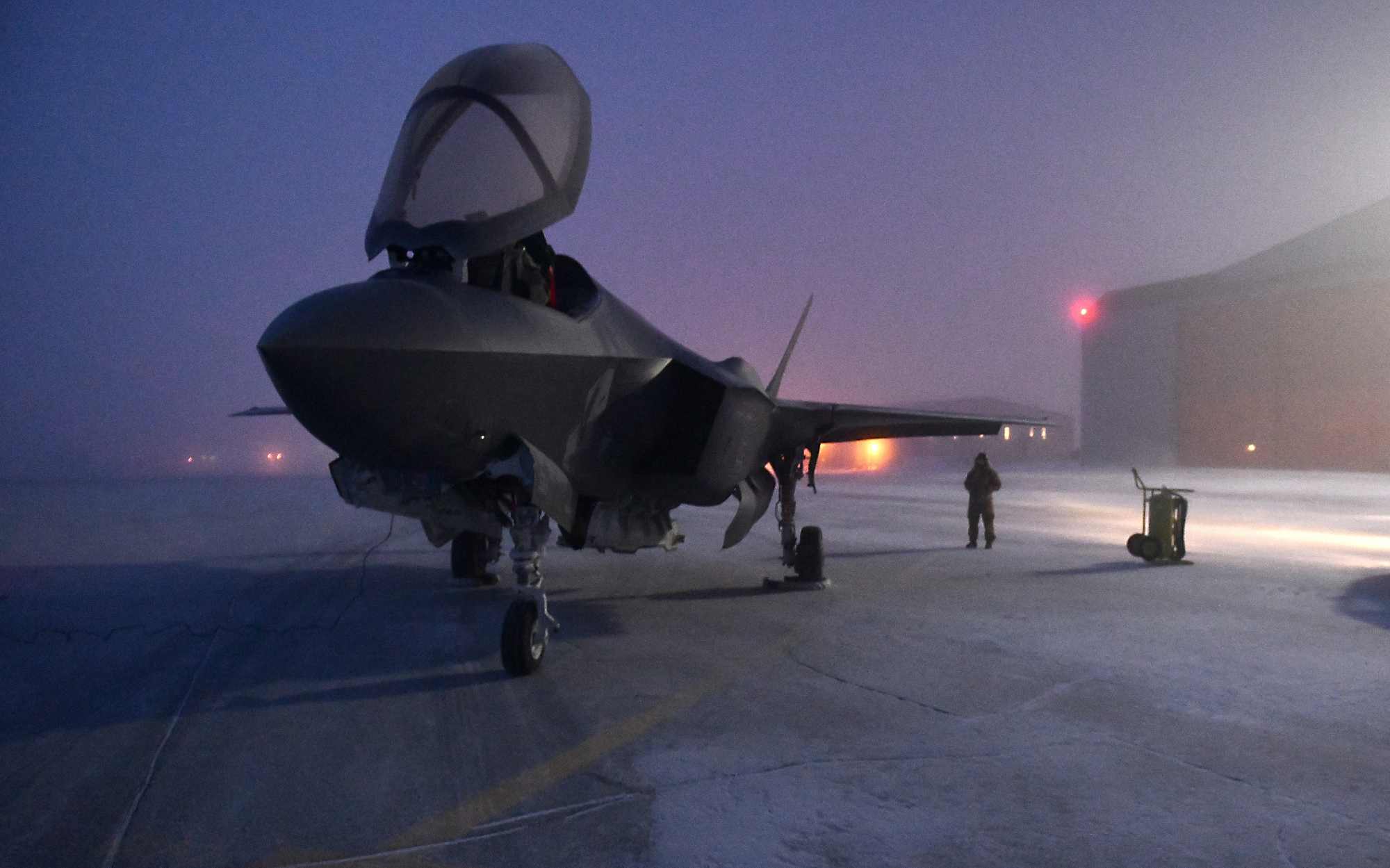US Defense Secretary Pete Hegseth has ordered the military to devise plans for major defense spending cuts over the next five years. While no information is available about which programs will see funding cuts, a nonpartisan watchdog has suggested three exorbitantly priced military programs that should be axed.
A memo issued by the Defense Secretary on February 20 called on military officials to submit proposals for an eight percent annual budget reduction over the next five years, The Washington Post reported.
“The time for preparation is over. We must act urgently to revive the warrior ethos, rebuild our military, and reestablish deterrence,” Hegseth wrote. “Our budget will resource the fighting force we need, cease unnecessary defense spending, reject excessive bureaucracy, and drive actionable reform, including progress on the audit.”
The order is in line with the Trump administration’s plans to reduce wasteful federal spending. Trump has appointed his aide, billionaire Elon Musk, as the head of the Department of Government Efficiency (DOGE), a newly established department dedicated to overseeing federal spending and initiating cuts in government expenses.
Hegseth said in a statement that the Department of Defense (DoD) will work with DOGE to achieve its goals. The Pentagon will immediately pull 8%—or roughly US$50 billion—from nonlethal programs in the current budget. However, he did not specify which nonlethal programs are under the scanner.
Robert Salesses, the deputy defense secretary, said, “The Department of Defense is conducting this review to ensure we are making the best use of the taxpayers’ dollars in a way that delivers on President Trump’s defense priorities efficiently and effectively.”
The memo has caused anxieties among lawmakers and officials about which programs would be sacrificed. However, shortly afterward, the Breaking Defense published a list of items that would not see spending cuts.
The list includes—Combating Transnational Criminal Organizations in the Western Hemisphere; Audit; Nuclear Modernization (including NC3), Collaborative Combat Aircraft (CCAs); Virginia-class Submarines; Executable Surface Ships; Homeland Missile Defense; One-Way Attack/Autonomous Systems; Counter-small UAS Initiatives; Priority Critical Cybersecurity; Munitions; Core Readiness; including full DRT funding; Munitions and Energetics Organic Industrial Bases; Executable INDOPACOM MILCON; Combatant Command support agency funding for INDOPACOM, NORTHCOM, SPACECOM, STRATCOM, CYBERCOM, and TRANSCOM, Medical Private-Sector Care.
The announcement has triggered a spate of speculation, with military watchers, enthusiasts, and netizens advancing various theories about which programs will be cut.
Notably, a US-based nonpartisan watchdog group, the ‘Project on Government Oversight’ (POGO), suggested three key ways to slash defense spending based on its own body of research undertaken over a period of time.
POGO Suggests 3 Key Ways To Cut Defense Spending
-
Stop Purchasing The F-35 Jets
POGO’s first recommendation is to axe the F-35 Lightning II stealth fighter aircraft.
The F-35 Lightning II is the USAF’s fifth-generation stealth aircraft, which it intends to use through the 2080s. The aircraft has been exported to several US allies and has become the cornerstone of the US Air Force (USAF). However, high costs and readiness issues have dented the aircraft’s reputation in recent times.
The watchdog says: “They are extremely costly and don’t work.”
The suggestion came amid concerns that Elon Musk’s previous public bashing of the aircraft could result in the end of the F-35 program. Musk thinks that the F-35, one of the US’s most advanced stealth fighters, is “expensive, complex,” and fast becoming “obsolete” in the age of drones.
In a tweet last year, the SpaceX CEO said, “The F-35 design was broken at the requirements level because it was required to be too many things to too many people. This made it an expensive & complex jack of all trades, master of none. Success was never in the set of possible outcomes. And manned fighter jets are obsolete in the age of drones anyway. Will just get pilots killed.”
“Meanwhile, some idiots are still building manned fighter jets like the F-35,” Musk said in another tweet.
However, military experts, veterans, and USAF officials have backed the aircraft, countering these assertions as ‘misleading and baseless.’ The F-35 has also proved its utility in combat, recently demonstrated in aerial strikes by the Israeli Air Force (IAF) in Iran. Though drones are essential to modern combat in networked battlefields, they are not expected to replace advanced, manned fighter jets any time soon.

However, the bigger issue plaguing the F-35 is its mounting cost, as flagged by watchdogs and officials worldwide.
For instance, the Pentagon’s 2023 Selected Acquisition Report estimated that the cost of a single F-35 would range from US$62.2 million to US$77.2 million, considering the benefit of selling aircraft to foreign governments. Some reports say the price could have gone up to US$80 million by now. That, too, is the base price, the final one depending on the model and extra features. All this makes the F-35 among the most expensive fighter jets.
Additionally, a report by Congress watchdog the Government Accountability Office (GAO) published in April 2024 suggested, “DOD’s projected costs to sustain the F-35 fleet keep increasing—from US$1.1 trillion in 2018 to US$1.58 trillion in 2023.”
The aircraft has also suffered from availability issues. The government watchdog discovered last year that while the Air Force is paying more and more to maintain its whole fighter fleet, mission capability rates—which gauge the proportion of time each aircraft can complete at least one of its missions—have only moderately improved.
-
Cancel The Sentinel Program
POGO’s second suggestion is to “Cancel the Sentinel program, which is massively over budget and unnecessary.”
Sentinel is the newest intercontinental ballistic missile program under development in the United States. Formerly known as the Ground-Based Strategic Deterrent (GBSD) program, the Sentinel project aims to modernize all three of the nuclear weapons’ legs — air, land, and sea — partially in response to China’s nuclear weapons posture.
However, the program has been criticized for being extremely expensive. It is expected to cost more than US$100 billion over the next few years.
According to one estimate, the cost of the ICBMs and related expenses, such as erecting silos, will be 50% higher than the current estimate of US$118 million made in 2020 (without counting inflation). In theory, that would result in the 659 missiles costing roughly US$117 billion, Bloomberg reported in 2023.
Even though the program is mostly supported by Congress, there have been concerns that rising costs could potentially trigger provisions of a 41-year-old rule that warns lawmakers about troublesome programs and forces the Pentagon to either clearly restate the program’s rationale or face termination. The USAF acquisition officials reportedly kickstarted a review after the Sentinel program office sent a “Program Deviation Report” to Air Force headquarters in 2023.

Moreover, some Western nuclear strategists believe that the program is unnecessary when viewed against the DoD’s other nuclear programs. They emphasize that the current U.S. nuclear arsenal is sufficient to withstand an atomic attack on the mainland and satisfies Washington’s requirements for first and retaliatory strikes, as previously explained by the EurAsian Times.
Western nuclear strategists have suggested that the US’s stealthy and qualitatively superior ballistic missile nuclear submarines and stealth bombers like the B-2 Spirit have enough first or retaliatory strike potential. It makes the US arsenal survivable to any Russian or Chinese nuclear strike aimed at destroying its nuclear weapons.
-
Nix The Constellation Class Frigate
The third program that POGO argues against is the Constellation-Class frigate program.
Based on the Fregata Europea Multi-Missione (FREMM) of Navy and shipbuilder Fincantieri Marinette Marine, the Constellation-class frigates will replace the troubled Littoral Combat Ship vessels, which are being decommissioned.
The Constellations were built to lower costs, delivery dates, and risk by modeling themselves after an existing, in-production frigate. However, they have turned out to be bigger and heavier and are currently years behind schedule.
The delays are, in part, due to the problems associated with the design. The FREMM design was modified for US service, which resulted in an increase in weight and dimensions.
It was discovered that the design’s current weight growth may cause the ships’ speed to drop below 25 knots, which would make it harder for them to compete with carriers and DDG-51s. It may also make it more challenging to upgrade the ships with newer technology in the future.
The Constellation-class ships are being built as they are being designed. Thus leading to delays. The first of the six ships on order may not be delivered before 2029. A 2024 GAO report stated, “The Navy reported that, as of September 2023, the shipbuilder had completed construction of only 3.6 percent of the lead ship as compared to the 35.5 percent it was scheduled to have completed by that point.”
However, POGO’s recommendations also received a lot of flak on social media. An avid follower of aviation and defense, Doha, said on X: “Your reminder that once upon a time, POGO was calling for the end of Super Hornet production (in favor of F-35C). They were also against the F-22 and most major US military acquisitions in the last 20+ years. These guys are deeply unserious people.”
The proposed cuts from the approximately US$850 billion defense budget will result in the slashing of tens of billions of dollars—the largest such cut-down since 2013 when the then-president ordered across-the-board spending reductions for all federal agencies and departments.
- Contact the author at sakshi.tiwari9555 (at) gmail.com
- Follow EurAsian Times on Google News




